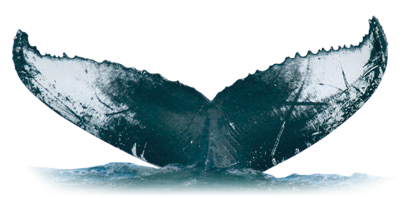


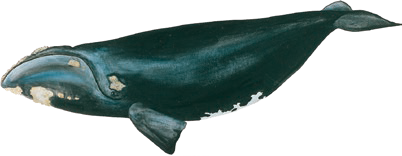

Sperm whale

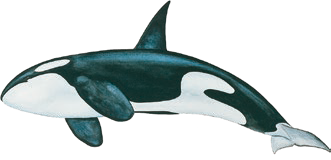
Killer whale
The largest of the dolphins is present almost everywhere in the world. A great hunter, it can attack animals much larger than itself. In the Pacific, it lives in very stable family groups. In the North Atlantic, they are few in number and scattered. Observations in the St. Lawrence are rare.
6 TO 7 M, UP TO 10 M
3 TO 7 T
LIFESPAN: 50 YEARS (MALES), 100 YEARS (FEMALES)
DIVE: 3 TO 5 MINUTES, UP TO 20 MINUTES

Northern bottlenose whale
Like the sperm whale, this whale is an expert in deep and long-duration dives. A small population lives off the coast of Nova Scotia. The only individuals observed in the St. Lawrence had stranded alive. Noise pollution is one of the threats affecting the species: bottlenose whales have perished elsewhere due to intense underwater noises associated with underwater exploration and military exercises.
6 TO 10 M
3 TO 7 T
LIFESPAN: 40 YEARS
DIVE: 3 TO 70 MINUTES, UP TO 2 HOURS

Minke whale
It is the smallest of the rorquals. When hunting fish near the coast, its pinkish belly is sometimes visible on the surface. Abundant throughout its distribution range, it is hunted in certain areas of the world.
6 TO 9 M, UP TO 10 M
6 TO 8 T, UP TO 10 T
LIFESPAN: 50 YEARS
DIVE: 2 TO 10 MIN, UP TO 20 MIN
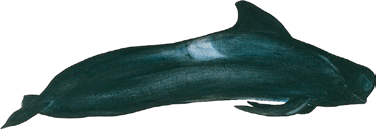
Long-finned pilot whale
With dark skin, a massive body, and a prominent melon on its head, the pilot whale doesn't have the typical appearance of other members of the dolphin family. It forms stable family groups of several dozen individuals. It's a regular visitor to the gulf, but rarely ventures up into the estuary. It's known for its mass strandings.
4 TO 5 M, UP TO 8 M
2 TO 3.5 T
LIFESPAN: 45 YEARS (MALES), 60 YEARS (FEMALES)
DIVE: 5 TO 20 MINUTES

Beluga
Among cetaceans, it has the most varied vocal repertoire. This Arctic species also has a small population in the St. Lawrence, where it underwent sustained hunting that ended in the 1970s. Considered endangered, this population now has to survive in a degraded environment.
WARNING! It is prohibited to approach within 400 meters of a beluga. If one approaches your vessel, move away slowly and cautiously.
4 TO 5 M
0.7 TO 1.5 T, UP TO 2 T
LIFESPAN: 60 TO 80 YEARS
DIVE: 2 TO 15 MINUTES

White-beaked dolphin
These two species form herds of hundreds of individuals. Curious and dynamic, they ride the waves of ships. The white-beaked dolphin occasionally visits the estuary. Both species regularly visit the gulf.
2 TO 3 M
180 TO 350 KG
LIFESPAN: 30 YEARS
DIVE: 1 TO 2 MINUTES

White-sided dolphin
These two species form herds of hundreds of individuals. Curious and dynamic, they ride the waves of ships. The white-sided dolphin occasionally visits the estuary. Both species regularly visit the gulf.
2 TO 2.7 M
180 TO 230 KG
LIFESPAN: 30 YEARS
DIVE: 1 TO 2 MINUTES
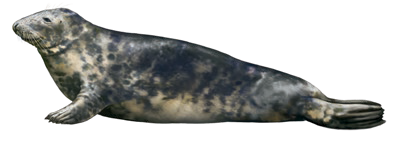
Gray seal
It is one of the largest seals in the St. Lawrence. It leaves the estuary for the cold season and breeds on the ice near Prince Edward Island and Sable Island, off the coast of Nova Scotia. It is abundant in the St. Lawrence. Rather gregarious on land, it is solitary when feeding at sea.
2 TO 2.4 M
225 TO 300 KG
LIFESPAN: 35 YEARS
DIVE: UP TO 30 MINUTES
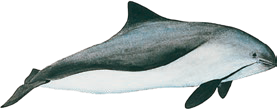
Harbor porpoise
The harbor porpoise is the smallest cetacean in the St. Lawrence and one of the smallest in the world, so much so that it is barely seen and heard. Females give birth each year in early summer. In the 1990s, thousands of porpoises died each year, accidentally caught in fishing nets. The situation has improved but remains concerning.
1.5 TO 2 M
45 TO 50 KG, UP TO 65 KG
LIFESPAN: 10 TO 13 YEARS
DIVE: 1 TO 3 MINUTES, UP TO 12 MINUTES
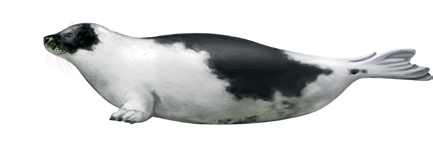
Greenland seal
It is a winter visitor to the St. Lawrence, but it is increasingly observed in the summer. It often forms large groups whose movements on the surface literally churn the water. The population in the St. Lawrence is estimated to be a few million and is subject to commercial hunting.
1.6 TO 1.9 M
85 TO 100 KG
LIFESPAN: 30 YEARS
DIVE: UP TO 15 MINUTES
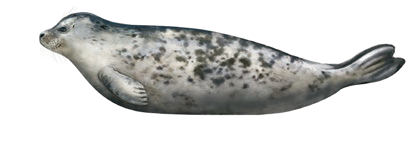
Common seal
This small coastal seal resides year-round in the St. Lawrence. It lives in groups on land while in the water it is solitary. In the estuary, the birthing period extends from mid-May to mid-June. Considered "not at risk," however, it is unknown how many individuals frequent the Saguenay-Saint-Laurent Marine Park area.
1.45 TO 1.55 M
100 KG
LIFESPAN: 20 YEARS
DIVE: BETWEEN 2 AND 30 MINUTES
Quelques baleines connues du Saint-Laurent
JAW-BREAKER (B246)
Jaw-Breaker is among the 15 to 18% of blue whales in the Saint-Laurent that show their tail when they dive. When she raises her tail, the white patch located on the edge of the left lobe is visible. Very faithful to the estuary, this female had a calf in 2022.
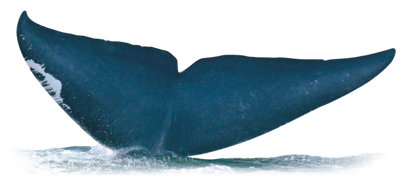
CAÏMAN (BP034)
Caïman est l'un des rorquals communs les plus souvent identifiés dans le parc marin du Saguenay-Saint-Laurent ! La première observation remonte en 1986 ! À cette époque, cette femelle semblait déjà être une adulte.

MISS FRONTENAC (BI2286)
Miss Frontenac is the first beluga to be tracked through photo-identification since her very first year. A deep scar appeared on her back a few weeks after her birth in 2004, allowing researchers to recognize her throughout the years. Becoming a mother herself, she gave birth to her first calf in 2014. In 2008, she was adopted by Fairmont Le Château Frontenac as part of the Adopt a Beluga campaign.
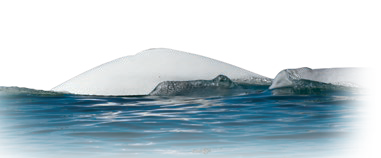
TIC TAC TOE (H509)
Diligent visitor of the Saint-Laurent, Tic Tac Toe wasn't even a year old when she was first observed in 1997, traveling with her mother, Quartz. Over the years, she has brought several calves into the Saint-Laurent, including Aramis, born in 2007, who is now a mother herself! She is distinguished by the "X" visible on the right lobe of her tail.
